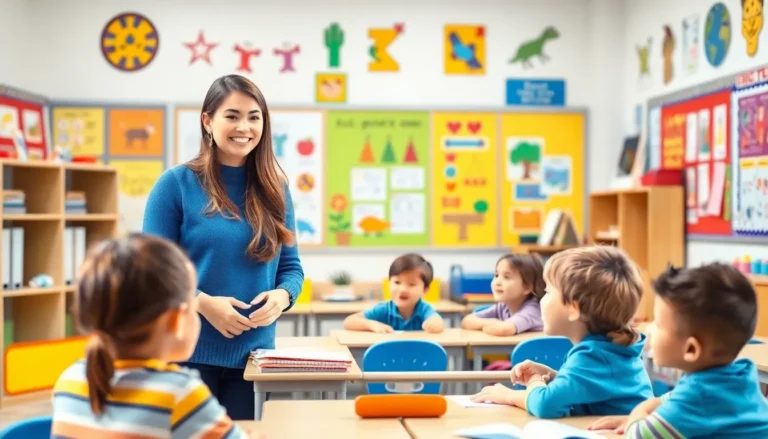In Mexico, students embark on an educational journey that lasts six years in elementary school. It’s a time filled with learning, laughter, and maybe a few too many math problems. Kids dive into subjects like math, science, and history, all while navigating the social maze of friendships and lunchroom politics.
But why six years? It’s not just about filling time; it’s about building a solid foundation for future success. This extended period allows young minds to explore their interests and develop critical skills. So while they might grumble about homework, they’re actually gearing up for the exciting challenges ahead. Join us as we explore the ins and outs of this unique educational system and discover why those extra years might just be the secret ingredient to a brighter future.
Table of Contents
ToggleOverview of Elementary Education in Mexico
Elementary education in Mexico consists of six academic years for students. This system caters to children aged six to twelve, providing them with a structured environment conducive to learning. Curriculum subjects encompass mathematics, science, language, arts, and physical education, fostering a well-rounded educational experience.
Teachers play a crucial role in guiding students through their academic journey. These educators utilize innovative teaching methods to engage young learners, promoting both critical thinking and creativity. Schools often emphasize collaborative projects, allowing students to work in teams and develop interpersonal skills.
Parental involvement remains significant throughout the elementary years. Families actively participate in school activities, including parent-teacher meetings and cultural events. This engagement strengthens the home-school connection, enhancing the overall educational experience.
In addition to academics, social development takes center stage during these years. Schools provide opportunities for students to participate in extracurricular activities, clubs, and community services. Such programs foster a sense of belonging and encourage children to explore their passions.
Education authorities recognize the importance of these six years. The extended duration allows students to build a solid foundation before transitioning to secondary education. Current reforms aim to enhance the quality of education and ensure all children benefit from this essential phase.
Statistical data reflects positive trends in elementary education. According to recent reports, enrollment rates in primary schools exceed 90%, showcasing the commitment to accessing education for all. Generally, extended learning reinforces skills that contribute to lifelong success.
Structure of Elementary School

Elementary education in Mexico consists of a six-year journey, crucial for laying a solid educational foundation. Students explore various subjects while developing vital social skills during these formative years.
Duration and Curriculum
Elementary school lasts six years, catering to children aged six to twelve. The curriculum covers subjects like mathematics, science, language, arts, and physical education. Emphasis on diverse subjects nurtures well-rounded individuals. Teachers employ innovative methods to keep students engaged, fostering critical thinking and creativity. This approach promotes not only academic knowledge but also life skills essential for future success. Education reforms aim to enhance the curriculum further, ensuring it meets the needs of a changing society. Enrollment rates in primary schools stand above 90%, demonstrating a commitment to accessible education for all.
Grade Levels
Students progress through six grade levels, with specific learning objectives for each. First graders focus on foundational reading and writing skills, while second graders delve deeper into mathematics and science. Third graders enhance their critical thinking abilities, and fourth graders begin exploring arts and physical education in greater depth. Fifth-grade students engage in more complex topics, consolidating their knowledge. Finally, sixth graders prepare for the transition to secondary education, cementing their learning experiences. Each grade culminates in assessments that ensure standards are met, promoting academic growth and readiness for the future.
Importance of Early Education
Early education in Mexico holds significant importance, establishing a solid foundation for lifelong learning and development.
Benefits for Students
Students benefit from a comprehensive curriculum that integrates various subjects, fostering well-rounded growth. They develop critical social skills through interaction with peers during group activities. Creativity gets nurtured in art and music classes. Opportunities for physical development arise in sports and recreational activities, promoting a healthy lifestyle. Support from teachers encourages individualized learning approaches, catering to diverse needs. Engagement in community service instills a sense of responsibility and teamwork. Educational authorities prioritize these benefits, ensuring that every child experiences a holistic education.
Impact on Future Learning
Future learning gets positively influenced by the foundational skills acquired during elementary education. Students who master essential reading and writing skills tend to excel in more advanced subjects. The critical thinking abilities cultivated during these six years directly impact adaptability in secondary education. Structured learning experiences prepare them for future academic challenges. Additionally, students who participate in extracurricular activities show enhanced motivation and determination. Educational reforms aim to strengthen this impact, ultimately contributing to higher enrollment rates in secondary schools, reinforcing Mexico’s commitment to accessible education for all.
Challenges Faced by Students
Students in Mexico encounter various challenges during their six-year elementary education journey. These obstacles influence their academic and personal development.
Socioeconomic Factors
Socioeconomic factors significantly impact students’ educational experiences. Families with lower income often face difficulties accessing quality education. Factors like transportation issues, employment demands, and unstable living conditions affect school attendance. Educational resources can be limited in poorer regions, resulting in disparities in learning opportunities. Moreover, parents with limited education may struggle to support their children’s academic progress. When socioeconomic status creates barriers, students may experience heightened stress that impacts their performance. Communities where families collaborate to uplift education tend to experience better outcomes, yet numerous students find themselves in challenging situations.
Access to Resources
Access to resources plays a crucial role in shaping educational experiences. Many schools in Mexico lack essential materials such as textbooks, computers, and technology. Limited access to extracurricular activities hinders students’ development of social skills and interests. Class sizes often exceed recommended limits, preventing personalized attention from teachers. However, some schools implement community engagement programs to enhance resource distribution. Libraries and study centers may remain underfunded, restricting students’ opportunities for independent exploration and research. Consequently, disparities in resource availability contribute to an uneven educational landscape, affecting students’ ability to thrive academically.
The six-year elementary school experience in Mexico plays a vital role in shaping students’ academic and social futures. This structured approach not only fosters essential skills but also encourages creativity and critical thinking. While challenges exist, particularly in underserved communities, the commitment to improving educational quality remains strong.
As reforms continue to enhance the learning environment, the focus on holistic development ensures that students are well-prepared for their next educational steps. The dedication of teachers and the involvement of families further enrich the educational journey, creating a supportive atmosphere for growth. Ultimately, these foundational years are crucial for nurturing capable individuals ready to contribute to society.






